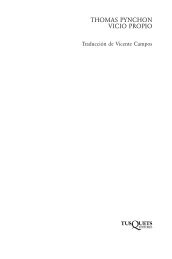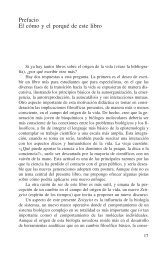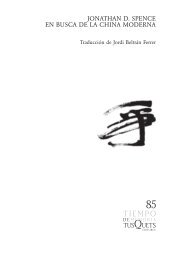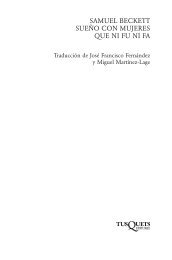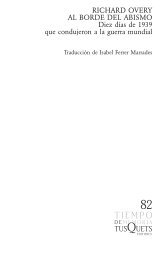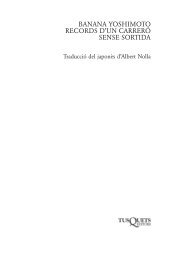001-344 Goethe y Schiller.qxd:Maquetación 1 - Tusquets Editores
001-344 Goethe y Schiller.qxd:Maquetación 1 - Tusquets Editores
001-344 Goethe y Schiller.qxd:Maquetación 1 - Tusquets Editores
You also want an ePaper? Increase the reach of your titles
YUMPU automatically turns print PDFs into web optimized ePapers that Google loves.
fe de <strong>Goethe</strong> antes del viaje. El diálogo epistolar sobre la percepción<br />
simbólica. <strong>Goethe</strong> tras las huellas de <strong>Schiller</strong> en Suabia.<br />
La idea de escribir Guillermo Tell.<br />
10 . . . . . . . . . . . . . . . . . . . . . . . . . . . . . . . . . . . . . . . . . . . . . 199<br />
<strong>Goethe</strong> y la sequía poética. El miedo de <strong>Schiller</strong> ante la obra<br />
y el delirio creador. Se cierra la barraca filosófica. El temple<br />
estético del espíritu. Wallenstein. El retorno triunfal al teatro.<br />
<strong>Goethe</strong> ayuda y admira. La idea del monstruoso todo del mundo.<br />
<strong>Schiller</strong> en la casita del jardín.<br />
11 . . . . . . . . . . . . . . . . . . . . . . . . . . . . . . . . . . . . . . . . . . . . . 215<br />
Sobre lo épico y lo dramático. Después de Las Horas de <strong>Schiller</strong>,<br />
Los Propileos de <strong>Goethe</strong>. Antigüedad y ausencia de fin. El<br />
coleccionista y los suyos. La novela de familia. Imagen de grupo<br />
con <strong>Schiller</strong>. ¿Cuánta realidad puede soportar el arte? La<br />
complacencia en lo esquemático. Contra el diletantismo. Fichte,<br />
expulsado de Jena. <strong>Schiller</strong> se traslada a Weimar.<br />
12 . . . . . . . . . . . . . . . . . . . . . . . . . . . . . . . . . . . . . . . . . . . . . 229<br />
La dramaturgia de Weimar. Contra lo desnaturalizado y lo<br />
demasiado natural. El duque gobierna el gusto. Ejercicios de<br />
traducción: el Voltaire de <strong>Goethe</strong>, el Shakespeare de <strong>Schiller</strong>.<br />
<strong>Goethe</strong>, el amigo y el jefe. María Estuardo. ¿Cuánta religión y<br />
cuál? Fausto y el derecho del más fuerte.<br />
13 . . . . . . . . . . . . . . . . . . . . . . . . . . . . . . . . . . . . . . . . . . . . . 249<br />
<strong>Goethe</strong> tiene demasiado mundo, <strong>Schiller</strong> demasiado poco.<br />
Asuntos románticos en casa de Schlegel. El triángulo de <strong>Goethe</strong>,<br />
Schelling y <strong>Schiller</strong>. Juana de Orleáns, de <strong>Schiller</strong> y La hija natural,<br />
de <strong>Goethe</strong>. El enfado en torno a Kotzebue. Descontento<br />
entre <strong>Goethe</strong> y <strong>Schiller</strong>.<br />
14 . . . . . . . . . . . . . . . . . . . . . . . . . . . . . . . . . . . . . . . . . . . . . 269<br />
Éxitos teatrales de <strong>Schiller</strong>. Prohibición de las exclamaciones de<br />
«viva». <strong>Goethe</strong> cede el tema de Guillermo Tell a <strong>Schiller</strong>. El revolucionario<br />
conservador. Madame de Staël en Weimar. La



